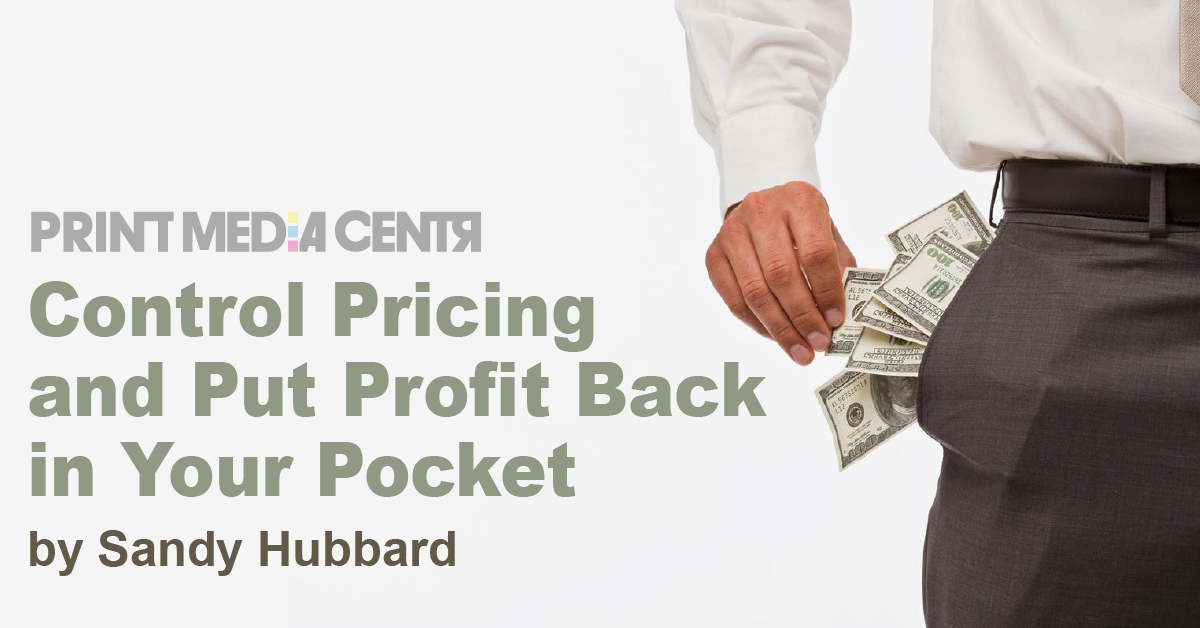Assumptions about pricing can kill your business.
Here’s an example. Recently I helped a printer get rid of half of his business that was dragging him down.
He had spent ten years using loss-leader pricing on half his products. For an entire decade, he made pricing assumptions without backing them up with facts. He had allowed his pricing philosophy to eat into the other half of his business — the profitable half.
“I was operating in a world of unreality,” the printer recalled. “We were discounting. That was our go-to strategy. We’d figure out our costs, set a price, and cut it in half as the first foray. We weren’t even breaking even, let alone adding mark up.”

He thought his approach was fine. When you looked at the profit for the entire business, the loss on the unprofitable half was barely visible. He was still covering overhead and providing jobs for his employees and family.
“Our building and equipment were paid off, so we assumed everything else was gravy, right?”
Wrong.
Assumptions. Will. Kill. Your. Business.
I reviewed this printer’s company financials, and I could see a trend on the bottom line.
As the cost of materials went up, he was losing more and more — and not offsetting it with the profitable side of the business.
Although he was aware of that trend, he thought it would be temporary and he could bounce back.
He sounded like a gambler actually. Even though he had years in the business, he was rationalizing.
He said things were sure to turn around. Material costs would go back down at some point. Paper, ink/toner, and gas prices would settle. Once he hired and train new people, those costs would go away. Customers would start paying on time again. Health insurance costs would get figured out.
Therefore, he said, he wanted to keep undercutting his competitors on price to get a foot in the door with customers.
Since that point, we’ve met a few times, and he is starting to wake up.
We’ve made honest predictions about the future costs of materials. We’ve looked at the labor market and the reality of having to recruit, hire and train regularly (and staff for overtime and fill-in workers) for many years forward.
With a plan in hand, this printer is psychologically prepared to focus on being profitable on both sides of the business. We can start working on how to attract customers without resorting to discounting. We can develop the marketing strategy and sales training now that we’re getting pricing under control.
I could end this post right here, but I just have to add an observation…
Many printers have a tendency to discount before the customer even asks for it. They assume it’s more convenient or desirable for the customer. That doing so will save the customer (and the printer) the time it would take to sell properly. That it’s worth it in the long run to discount just to get a job in the door. That everyone buys on price. That salespeople will motivated to sell if they can respond to the pricing demands of customers.
Not true in my experience.
Instead, you must create a pricing toolkit and sales approach that is rational and sustainable.
Here’s where to start:
- Ditch loss-leader pricing. You rarely “make up for it” on future jobs.
- Avoid break-even pricing except as a well-informed business strategy.
- Open with a fair price, and teach your salespeople to sell this way.
- Create a pricing tier for premium customers who prefer extra support and service (yes, they’re out there!).
- On the other end of the spectrum, create a tier for discount hunters and sell them low-priced items with a healthy markup (and produce these jobs as efficiently as possible).
- Continue to run the numbers on all pricing scenarios to make sure they are worthwhile. Some customers will never be profitable, and that’s the truth.
- Have a voice conversation with every customer to get clues about areas where prices can be negotiated. Discuss when invoices will be paid; whether there’s wiggle room in the job’s delivery time or date; and which specs can be altered to get the project in line with the budget. For the tough negotiating customer, agree on something the customer can commit to, “trade” or concede in return for better pricing.
- Don’t operate in fear of OPP (other people’s pricing). Your competitors’ prices could be and probably are built of straw. If you want to know if your competitors are truly profitable over the long haul at the prices they’re quoting, the truth is out there.
- Become leaner and operationally efficient so your pricing will be competitive AND profitable.
Test your assumptions, support your decisions with data, and take control of your pricing,
We’re all operating in an unfamiliar new arena. Pricing is going to play a huge part in who survives and who doesn’t.
If you are looking for growth, be smart. Take a hard look at how pricing is affecting your business, and create a plan to put profit back in your pocket.
[Agree? Disagree? Comment below! Read more from Sandy here.]
 Sandy Hubbard is an expert Marketing Strategist specializing in the Printing Industry. She consults with Print CEOs and owners of print, media, and platform businesses of all sizes — helping marketing teams build visibility and increase sales.
Sandy Hubbard is an expert Marketing Strategist specializing in the Printing Industry. She consults with Print CEOs and owners of print, media, and platform businesses of all sizes — helping marketing teams build visibility and increase sales.
Sandy is also co-host of #PrintChat, a weekly discussion on LinkedIn. Join the group here.











